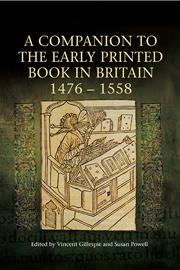Book contents
- Frontmatter
- Contents
- List of Illustrations
- List of Contributors
- Preface
- Acknowledgements
- Abbreviations
- Chronology of the Period
- Introduction
- I THE PRINTED BOOK TRADE
- II THE PRINTED BOOK AS ARTEFACT
- III PATRONS, PURCHASERS AND PRODUCTS
- 7 Merchants
- 8 The Laity
- 9 The Secular Clergy
- 10 The Regular Clergy
- 11 Universities, Colleges and Chantries
- IV THE CULTURAL CAPITAL OF PRINT
- Index of Manuscripts
- Index of Printed Books
- General Index
9 - The Secular Clergy
from III - PATRONS, PURCHASERS AND PRODUCTS
Published online by Cambridge University Press: 05 April 2014
- Frontmatter
- Contents
- List of Illustrations
- List of Contributors
- Preface
- Acknowledgements
- Abbreviations
- Chronology of the Period
- Introduction
- I THE PRINTED BOOK TRADE
- II THE PRINTED BOOK AS ARTEFACT
- III PATRONS, PURCHASERS AND PRODUCTS
- 7 Merchants
- 8 The Laity
- 9 The Secular Clergy
- 10 The Regular Clergy
- 11 Universities, Colleges and Chantries
- IV THE CULTURAL CAPITAL OF PRINT
- Index of Manuscripts
- Index of Printed Books
- General Index
Summary
The secular clergy might well be assumed to be a major supporter of print. After all, from the time of the Fourth Lateran Council (1215), their duty had been both to preach and to teach: to preach regular sermons to their parishioners and to teach them, at least quarterly, the basic tenets of the Church, as well as to prepare them for confirmation, marriage and death, and to confess them, even if only at Easter. If these duties could be supported by the written word, it could only be advantageous to all. Moreover, not all clergy were themselves prepared for these duties, and needed to be instructed, again, most easily, through the written word.
For the numbers of clergy with a duty of care to a parish the singly produced manuscript could achieve little. However, the opportunity of multiple copies of a printed text made feasible the education of many. Printed books were also much cheaper than manuscripts, and so available to a wider audience of the literate than in the pre-print era. Certainly, there is plenty of evidence that, in those institutions where mass education was required, the value of print became evident very quickly.
However, in her analysis of the market of English printers in the incunable period, Lotte Hellinga puts the clergy well below laymen as clients of, respectively, Caxton, de Worde/Notary and Pynson. As a group, their use of the printers was, however, normally higher than that of other interest groups: scholars and the universities, schools, lawyers and offi cial publications.
- Type
- Chapter
- Information
- A Companion to the Early Printed Book in Britain, 1476-1558 , pp. 150 - 175Publisher: Boydell & BrewerPrint publication year: 2014

